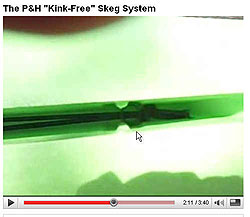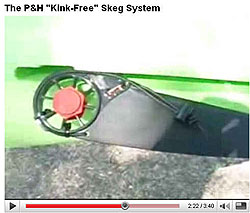I just read on the site of P&H that they invented a new skeg system.
In contrary to other developments in the market, they claim to have followed the path for a simple solution which is also field maintanable.



Last year, P&H launched their new “kink-free” skeg system. The system combines the best of both worlds: the ease of maintenance of a rope skeg with the precise trimming found in cable skegs. Moreover, the system is lightweight and fully field maintainable. While some kayak companies are making things more complicated (pneumatic skegs, for instance), I think the P&H approach of simple solutions for simple problems makes a great deal of sense.
Like anything new, however, there’s a bit of a learning curve involved as people learn how the new technology functions. In my travels this summer, I’ve come across a few paddlers who’ve said they find the new skeg difficult to deploy. As it turns out, every one of those individuals was engaging the click slider on the skeg the wrong way. As soon as I showed them the correct technique (pushing forward to unlock the slider, not squeezing the trigger!), they were thrilled.
To get the word out, I put together this little video going over the system [Please click HERE], how to deploy it, and how to adjust the tension on the skeg. Considering I was able to remove and replace the skeg system with one hand, while filming with my digital camera in the other, I’d say it’s pretty easy…even for a guy with two left thumbs like me! Enjoy!
by Mark Pecot
With this development they opgraded the oldest, first skeg system for seakayaks, which made use of a rope to adjust the skeg.
I was never very enthousiastic about this rope system because you had to apply quite a lot of force to adjust it. Sometimes you even had to use both hands to pull the rope. Besides this it was not very accurate in fine-adjustments.
But I must say: this new system looks pretty good to me! In fact I am enthousiastic because this is a real improvement of the old rope-system!
Of course I would like to test this system myself, just to judge if it is really fine-adjustable.
There is of course also a down-side: the lock system which holds the skeg in the required position may not slip because in that situation the skeg will automatically lower to maximal position. When this happens you will have your kayak leecocking, which can give you a bad experience in heavy weather.
On the other hand: the cable controlled system has also a downside: the cable can be damaged. In that case you can not use nor adjust the skeg. Depending on your kayak you will be faced with a weathercocking kayak to a more or lesser extend.Only when the skeg is blocked in the down-position it may result in leecocking.
So both systems has their disadvantage. Choosing, thinking about a situation with a defect, I have a minor preference for the cable controlled system as a defect will result in weathercocking which is easier and safer to handle than leecocking.
But you will have to make up your own mind.
I am interested in your experiences in case you were able to work with this new system. You are welcome to give your comments below.
